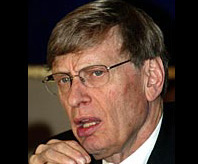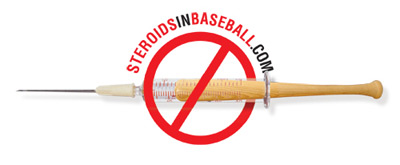Steroid Hall of Shame | Balco Timeline | Steroid Timeline | Mitchell Report




Home Page
Steroid Overview
Steroid Timeline: From Germany to USA
Commissioners and Controversy
- Kenesaw Landis
- Albert Chandler
- Ford Frick
- Colonel Eckert
- Bowie Kuhn
- Peter Uberroth
- A. Bartlett Giamatta
- Francis Vincent
- Alan Selig
Balco Timeline
Mitchell Report (409 pg pdf)
2002-06 Collective Bargaining Agreement (pdf)
2007-11 Collective Bargaining Agreement (pdf)
Allan "Bud" Selig
Acting Commissioner of Baseball
1992-July 9, 1998
Ninth Commissioner of Baseball
1998-Present
(page 3)
Roger Maris' 1961 home run record (61) goes bye-bye (seven times in four years):
• 1998:
Mark McGwire hit 70 home runs.
Sammy Sosa hit 66 home runs.
• 1999:
Mark McGwire hit 65 home runs.
Sammy Sosa hit 63 home runs.
• 2000:
Sammy Sosa hit 65 home runs.
• 2001:
Barry Bonds hit 73 home runs.
Sammy Sosa hit 64 home runs.
In 15 full baseball seasons prior to 2001, Barry Bonds had never hit more than 49 home runs in a single season, averaging just under 33 home runs a season. What could possibly have happened to so suddenly and dramatically change all that? In 2001, despite the recent explosion in home runs, there was no mention of MLB drug or steroid testing from within the baseball hierarchy. Commissioner Selig did manage to establish a minor league drug policy that basically replicated Fay Vincent's 1991 MLB drug package. It was easy for Selig — he did not have to deal with the MLBPA because minor league players had no union protection.
In May 2002, retired major league player Ken Caminiti admitted that he had used steroids when he won the National League Most Valuable Player award in 1996. In response, Selig said,"I've been concerned for the last two or three years." Apparently, he wasn't sufficiently concerned to take any action.
On June 19, 2002, union leader Donald Fehr appeared before a U.S. Senate panel and stated that the MLBPA would give serious thought to the issue of player steroid use.
During the summer of 2002, a USA Today poll of 556 major league players indicated that they would accept independent testing for steroids.
Although many people "around" baseball were saying that the players were switching from steroids to human growth hormones, baseball star Tony Gwynn stated that at least 50 percent of the players were on greenies (amphetamines).
Then something truly momentous happened. The MLBPA, on August 7, 2002, placed a proposal on the collective bargaining table that called for testing players for illegal steroids. This came about as a response to the fans' outcry over the widespread allegations made about performance-enhancing drug usage. The first phase of the testing plan would cover two seasons (2003 and 2004) during which testing would be done for survey purposes only. If the survey showed that more than five percent of the players tested positively, the testing program would move to its second phase. This phase would call for random, unannounced testing that would be in place for two years, bringing MLB up to the next collective bargaining period. The union's proposal also called for the testing of illegal steroids if MLB had reasonable cause to believe that an individual player was a user. There followed a little negotiating here and there, but the bottom line was that the first proposal to test for steroids was presented by the players' union, not by Commissioner Bud Selig.
In February 2003, Yankee pitcher David Wells' book hit the stands, claiming that 25-40 percent of all major leaguers were "juiced" and that the number was rising fast. Wells further stated that steroids were readily available to players and that amphetamines were commonplace within the clubhouses. Wells' book echoed rumors that had been pervasive in and around MLB for many years.
In March 2003, steroid testing began during spring training, just as the players' union had proposed. Curiously, 12 White Sox players refused to be tested because they believed that the testing should be more aggressive in order to weed out the drug users.
The end of the 2003 season marked five years since andro had been spotted in Mark McGwire's locker. Incriminating books had been published, and numerous players had admitted using performance-enhancing drugs. But, still, Bud Selig did nothing.
***You are on page 3 ***
This website & Syringe Logo are owned and copywritten by Allan Doherty 2006 - 2009.